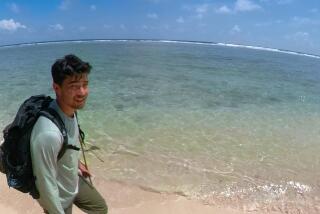GIs got a warm welcome from villagers
- Share via
MYITKYINA, MYANMAR — Long before war brought Evelio Grillo and his comrades to Burma, they had allies ready to welcome them in the northern villages. By a quirk of fate, or divine hand, this was Burma’s Baptist belt.
In 1813, an American missionary named Adoniram Judson had crossed the border from India into mainly Buddhist Burma and become the country’s first Protestant missionary.
When Judson asked the king for permission to do missionary work among the illiterate Kachin tribes, the monarch laughed and told him he would have a better chance teaching the royal dog.
Judson focused instead on the Kachin, learned their language and customs, and after almost six years in Burma, he baptized his first convert. Many others quickly followed, and more than 120 years later, when American soldiers needed help, tens of thousands of villagers, descendants of Judson’s converts, were there to lend a hand.
Judson was a household name in Kachin villages, which made a big difference when the road brought another American, Lt. Malcolm McKenzie, to eastern Burma in early 1945. He was an intelligence officer in Detachment 101 of the Office of Strategic Services, the precursor to the Central Intelligence Agency, and his mission was to persuade the Kachin to spy on Japanese forces to find targets for U.S. tanks and artillery.
Howa Zau Gam was 18 when McKenzie walked into his family’s hut in the village of Howa, near the Chinese border. His elementary school closed when the Japanese invaded Burma in 1942, but Howa Zau Gam had picked up enough basic English and Chinese to impress McKenzie, who hired him as an interpreter in his second meeting with his father, the chief.
Along with three others recruited into the Kachin Rangers, villagers in U.S. Army uniforms armed only with long knives and carbines, Howa Zau Gam crept through the jungle with McKenzie spying on the Japanese. They carried out their reconnaissance missions without firing a single shot.
“We were very clever, you see,” he said with a smile. “We didn’t have to shoot to fight the Japanese. We just used information.”
Now 81, Howa Zau Gam is a humble, soft-spoken man in a crisply ironed sport shirt and a green-and-blue-plaid longyi sarong. Reading through his files with a magnifying glass, he insists his war didn’t amount to much. Others sacrificed much more.
Looking down on him from a living room wall is a large poster of Christ, with a broad halo of golden light, hovering above a panoramic view of the Holy Land.
On another wall, a framed black-and-white news photo shows Burma’s first prime minister, U Nu, presenting President Eisenhower with a check for $5,000 to help families of U.S. servicemen who died or were injured in the war.
It’s a silent protest against the constant barrage of anti-American propaganda from the generals who rule Myanmar.
“The regime is not aware of these things,” Howa Zau Gam said, admiring the picture. “That’s why I put it there.”
More to Read
Sign up for Essential California
The most important California stories and recommendations in your inbox every morning.
You may occasionally receive promotional content from the Los Angeles Times.












